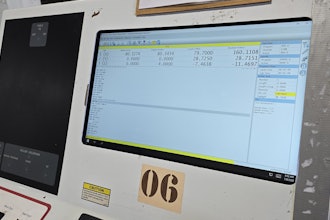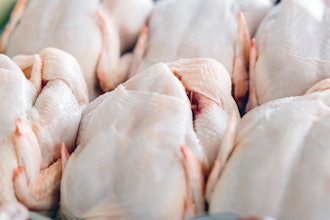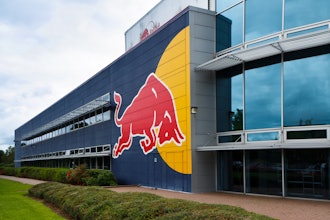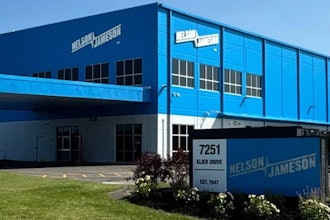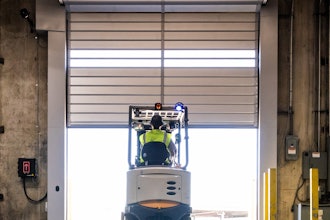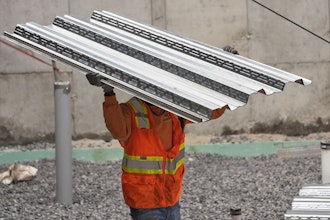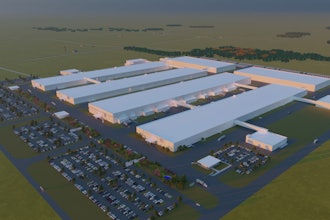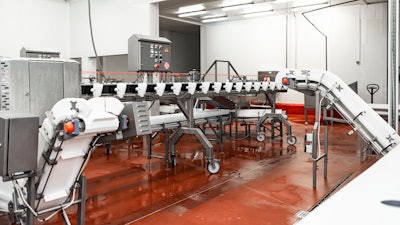
Meat processing facilities face challenges in their daily operations. Demands include ensuring food safety, maintaining high throughput, and adhering to regulatory standards. Processing different types of meat with unique handling and temperature requirements makes this even more difficult.
Finding a conveyor system that meets these standards while being cost-effective and easy to maintain is vital to keeping a processing facility safe and efficient. Fortunately, there are solutions designed to address these specific needs.
Read on to learn more about choosing the right meat-processing conveyor.
Consider These Meat Processing Conveyor Selection Factors
Conveyors are essential in maintaining food safety, sanitation, and product quality during the primary (butchery) and secondary (dicing/portioning) processing stages through packaging.
Choosing a meat processing conveyor that can fulfill the many requirements of a busy facility involves careful consideration.
Here are some factors to think about.
1) Hygiene Standards and Sanitation Requirements
Maintaining impeccable hygiene and sanitation standards is crucial for ensuring food safety and operational efficiency in meat processing facilities.
Here’s how compliant conveyor equipment plays a pivotal role:
- Stringent Standards Compliance: Food-grade conveyors must meet rigorous hygiene standards set by organizations like the American Meat Institute (AMI) and the USDA.
- Regulatory Adherence: Facilities must comply with HACCP and FDA regulations to minimize contamination risks and uphold product quality.
- Minimizing Cross-Contamination: Conveyor systems designed with accessibility and ease of cleaning help mitigate cross-contamination risks during processing.
- Operational Efficiency: Adhering to these regulations contributes to safer and more efficient operations, avoiding legal and financial repercussions that can harm a company’s reputation.
By prioritizing hygiene and sanitation in equipment selection, meat processing facilities can optimize efficiency, reduce costs, and ensure the highest food safety standards.
2) Type of Meat and Application/Process
The type of meat plays a critical role in selecting the right conveyor system. For example, ground meat requires different handling than hot dogs or frozen chicken tenders. Raw meat must be kept at specific temperatures for safety reasons.
3) Product Integrity and Yield
It’s essential to maintain high throughput capacities while preserving product integrity. Conveyance systems must prioritize gentle handling and minimal product damage. Beyond regulatory requirements, food safety practices significantly influence product quality, yield, and operational efficiency.
- Extended Product Life: Effective sanitation practices prevent bacterial growth, extending product shelf life and reducing waste in processing.
- Minimizing Waste: Conveyors can be equipped with return lines that send stray bits back to previous processes or fitted with catch pans and accessories designed to capture them.
4) Throughput Capacity: Capacity & Uptime
Meat moves quickly from farm to slaughter to processing—poultry moves even faster. Conveyors need to be durable and reliable to run consistently with little maintenance. This ensures total uptime in a fast-paced meat processing environment.
5) Full Solution Versus Individual Conveyor
It’s crucial for meat processing facilities to choose between a complete conveyor system and individual conveyors. A complete system offers seamless integration and enhanced automation, improving overall efficiency. On the other hand, individual conveyors provide more customization options to meet specific processing requirements.
Look at the entire process. This includes conveying equipment and as much automation upstream and downstream as possible. Options or equipment can automate additional processes. Services to consider are:
- Engineering layout design
- Expert opinions and advice
- FAT/testing availability
- Installation
- Millwright services
Utilizing OEM connections can create complete process systems through a one-stop shop. This approach is typically reserved for engineering firms and dealers or distributors that manage entire projects.
6) Material and Design Considerations
Selecting the right materials and designs for a conveyor system is crucial in meat processing. Conveyors must be made from stainless steel resistant to corrosion and bacteria growth to ensure easy cleaning and sanitation. These materials must also withstand cleaning chemicals used in the process.
Designs must allow easy access for maintenance and cleaning. This reduces downtime and increases overall efficiency. Easy-to-clean equipment maintains hygiene standards and ensures smooth conveyor system operation.
Types of Meat Processing Conveyors
Processors can choose from a range of conveyor systems designed specifically for meat processing applications. Conveyors should meet exceptional sanitation standards and comply with industry regulations.
Belt Conveyors
Belt conveyors are popular in meat processing due to their versatility, long-distance conveying, and low initial cost.
- Flat belt conveyors are simple, modular solutions that fit throughout meat processing lines. Tight transfers, seamless integrations, and various belt materials keep production running for raw, cased, and processed meats.
- Trough belt conveyors are ideal for conveying bulk meat across long distances with no loss.
- Incline belt conveyors elevate meat to processing equipment like mixers, blenders, ovens, and more.
- Vertical lift conveyors have traditionally been used for dough handling but effectively elevate ground meat.
Bulk Handling Equipment
Bulk handling on the raw and kitchen sides uses dumpers to efficiently move large volumes of meat. These dumpers provide smooth and safe transfers while maintaining productivity. Their flexible and easy-to-clean design meets high sanitation standards.
Dumpers and Screw Augers
Dumpers efficiently unload bulk product totes to quickly introduce product to the processing line. They handle products smoothly to minimize contamination. Screw augers precisely move bulk materials without spillage or loss while maintaining product temperature and integrity.
Both equipment types improve workflow and uphold sanitation standards. Their design allows easy cleaning and flexibility, which is crucial for productivity and safety in processing environments.
Bucket Elevators
Bucket elevators are perfect for moving products to different heights. They are ideal for elevating products to tall processes (or equipment), including slicing/dicing/portioning/grinding and packaging.
Vibratory Conveyors
Vibratory conveyors provide gentle product handling and are typically used in frozen and processed meat lines feeding into packaging lines. They ensure efficient and sanitary product transfer.
These conveyors maintain product integrity and reduce the risk of cross-contamination. They offer precise control over product flow, making them ideal for applications requiring careful handling and distribution.
Choosing the Right Meat Processing Conveyor Solutions Helps Ensure Food Safety
Choosing a conveyor system that prioritizes safety, efficiency, and adherence to industry standards is essential. Conveyor solutions may also need to be customized to fit a processor’s needs.
Look for a vendor with the industry experience needed to design a solution that works well in the facility’s environment and conditions.
Shane Peterson is a key accounts manager with PFI.











